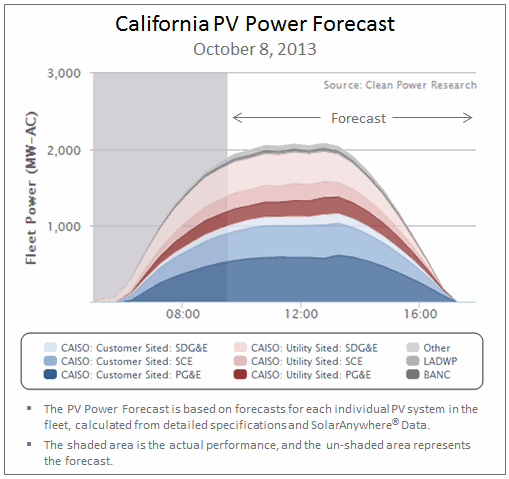Falling photovoltaic (PV) system prices along with financing and installation innovations are driving continued rooftop solar growth—expected to be 30% in 2013 as reported by GTM Research. These customer-sited power generation resources are increasingly impacting operations, from the local utility level to as widely as independent system operator (ISO) and regional transmission organization (RTO) service territories. To maintain reliable energy delivery and to keep costs low, utilities and ISOs/RTOs must take into account the power generated by these variable resources in scheduling and real-time load balancing.
The California Independent System Operator (CAISO) is on the cutting edge of implementing systems to forecast distributed PV power production. At current penetration levels, the CAISO supports more than 3 GW of peak PV generation. Half of this generation is provided by more than 170,000 residential and commercial PV systems.
Electricity generation from these distributed resources directly impacts the CAISO’s serviceable load. While the CAISO load varies depending on time-of-day and day-of-year, PV output is typically greatest during times of peak demand: when it’s hot and air conditioners are in full use. For example, on a hot day in August 2012, the CAISO experienced a peak customer load of roughly 45 GW, which means that the existing installed, distributed PV fleet could have satisfied as much as 3% of the load for parts of the peak day.
The challenge of forecasting PV fleet production
Many of these distributed residential and small commercial systems are ‘behind-the-meter, which means there is no information available about the power these systems are producing at any given time. As a result, utilities and ISOs must find other ways to measure and forecast power production for planning and load balancing.
In collaboration with the CAISO, Clean Power Research has been working on a solution with funding from the California Solar Initiative Research, Development, Demonstration and Deployment (CSI RD&D) program and the California Energy Commission. The result was the launch of SolarAnywhere® FleetView®, which is today forecasting power production for the CAISO’s entire fleet of installed PV—more than 170,000 systems distributed across its service area.
The forecasts match the time horizon and interval requirements for the day-ahead market and the real-time pre-dispatch market. The image below shows the actual FleetView® PV power forecast for the CAISO on October 8, 2013.

FleetView uses SolarAnywhere® high resolution satellite-derived solar resource forecasts, a database of installed systems, and patented variability methodologies to model power production of any size ‘fleet’ of PV systems. A fleet can consist of a few systems located on a distribution feeder, or hundreds of thousands across an entire load-balancing area.
The combination of actual installed PV system specifications and location-specific insolation data is a unique approach that increases output accuracy without requiring on-site measuring equipment. For the CAISO forecast, specifications for the majority of systems in the CAISO balancing area came from the CSI database, which is generated from PowerClerk® Incentives, the online system that has been used to administer the incentive programs for California’s three investor-owned utilities.
How PV fleet production data supports integration
Data generated from FleetView supports reliable, cost-effective integration of distributed PV by providing the information needed for system design, resource planning and forecasting. Specific uses include:
- Distribution system voltage analysis. Variability of distribution-level fleets can be quantified, taking into account their actual geographic diversity, to provide engineers with accurate expectations of fleet power variability. This can reduce distribution costs by enabling design engineers to correctly size voltage regulators and capacitors, and to evaluate the need for inverters with voltage control.
- Load scheduling. Fleet power forecasting provides grid operators with more accurate “net” load forecasts, thereby improving the efficient scheduling of generation resources, and lowering costs to all electric customers.
- Frequency regulation. Fleet variability forecasts enable grid operators to determine the required resources for frequency regulation. By including actual geographic diversity and required time interval data, it’s possible to efficiently allocate regulation reserves.
- Resource modeling. Fleet modeling and load shape analysis provide resource planners with expected future ramp rates and supplemental generation requirements under high PV penetration scenarios. By modeling “as built” PV fleet capacity, hourly load simulations accurately reflect details about PV geographic placement, system configuration practices, localized weather patterns and operator-defined planning regions. Utilities can use this information to better plan for generation reserves.
The next step: operational tool integration
Clean Power Research is currently working with the CAISO to integrate FleetView forecasts into the CAISO Short Term Forecasting Group’s Automatic Load Forecasting System (ALFS) solutions to improve hour-ahead and day-ahead load forecasts. Successful implementation of FleetView into the state-of-the-art load forecasting tools the CAISO already uses will enable the CAISO to operate more efficiently.
The project will also demonstrate how other utilities and ISOs can cost-effectively integrate their growing, distributed PV fleets by leveraging new PV fleet data sources into their existing planning tools. Managing the growth of distributed PV will be vital to sustaining the utility business model through smart integration of their distributed power generation resources.
